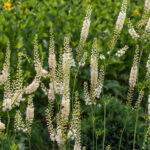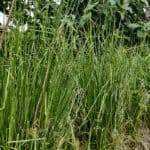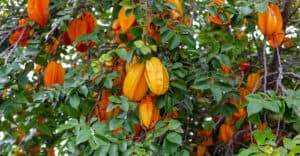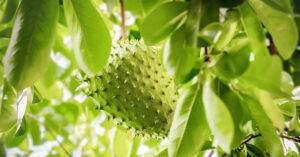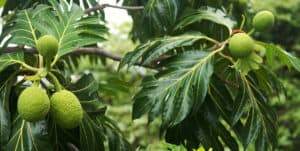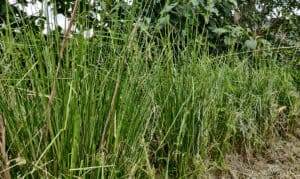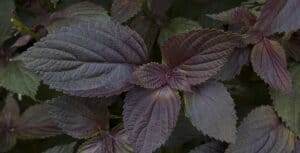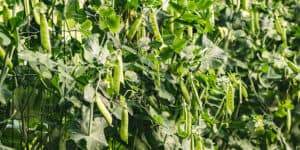
If you are looking for a quick growing annual with tons of other benefits and applications, consider integrating Fenugreek into your space and life!
Fenugreek has been used as a multifunctioning element in traditional Indian farming as a ground cover, chop and drop, fodder, home remedies for hair and skin and more. A must in Indian kitchens, it is used as both herb and spice in Indian Cuisine and has been an active ingredient in Folk medicine and Ayurveda for centuries.
Its botanical name is Trigonella foenum-graecum), it is an annual herb belonging to the family Fabaceae. It is believed to have been domesticated and brought into cultivation from the eastern Mediterranean region however the specific details of its origin are not well documented as its cultivation dates back to ancient times. It is cultivated across the globe, especially in India, Pakistan, Iran, Egypt, Morocco, China, France and more.
In India, it is grown in most of the states with Rajasthan being the highest producer, contributing around 80% of total production. It’s called Methi in Marathi, Bengali, Gujarati, Odia, Punjabi and Hindi, Venthayam in Tamil, Uluva in Malayalam, Mentulu in Telugu and Menthya in Kannada.
Plant Description
Fenugreek is an annual herb that typically grows up to 1 to 2 feet (30 to 60 centimeters) in height.
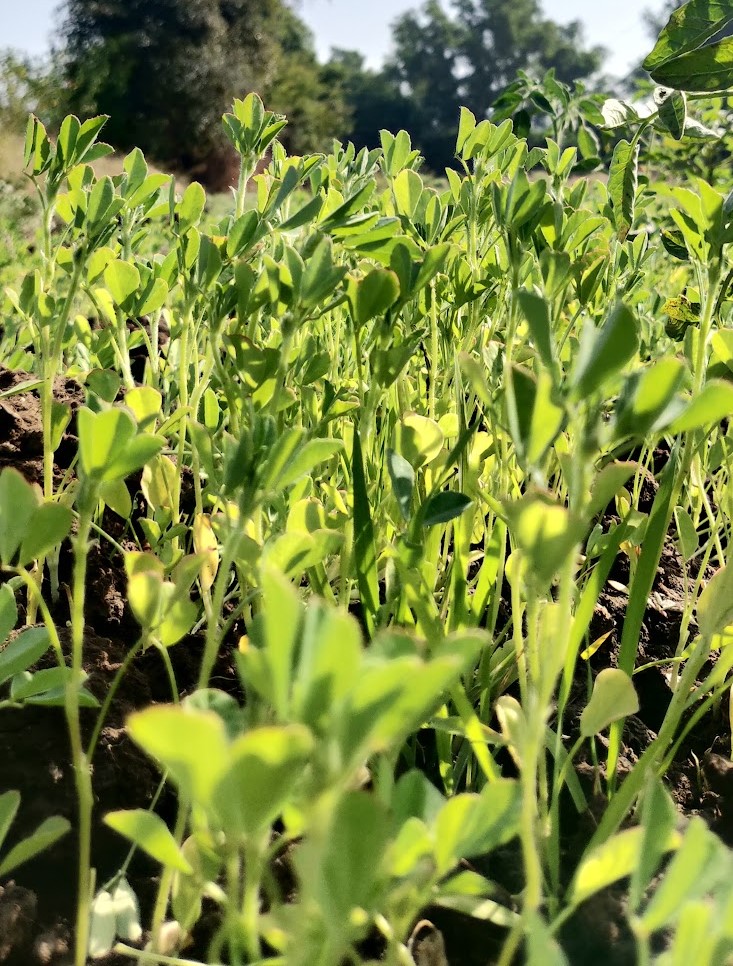
It has trifoliate leaves, with each leaflet benign obovate or lanceolate in shape.
The herb produces small white or yellow flowers, which are followed by seed/ bean pods. The pods are long, slender, and green in color. Each pod roughly contains 10 to 20 small, golden-brown seeds.

What Properties Make Fenugreek a Traditional Favourite?
Fasting Growing
Fenugreek plants are known for their faster maturity, which is in between 3 to 4 months making them desirable for larger production and consumption. In India, the plant can be seen growing throughout the year for seeds, as a microgreen and leafy green.
Nitrogen Fixing
Being a legume, fenugreek forms symbiotic relationships with rhizobium bacteria enabling the plant to fix atmospheric nitrogen into root nodules and ultimately, in soils. It is used in traditional crop rotation systems in annual fields and temporary ground cover.
Chop and Drop
Under favourable conditions, it can grow up to 30 cm tall and reach 30 to 45 cm spread within a month, this makes it ideal for chop and drop. Additionally, the biomass is rich in nitrogen, phosphorus, potassium, calcium, iron and manganese, this makes it a great nutrient recycler for your soils as well.
Medicinal Properties
Fenugreek is highly medicinal and it’s one of the reasons why it is included in daily preps in micro qualities consistently. It is majorly known in traditional medicine for its anti-inflammatory properties and helping maintain mucus conditions of the body, mostly the lungs, by helping clear congestion. Additionally, they are a rich source of phytochemicals which are believed to have antioxidant and anti-inflammatory properties.
Staple Crop
Fenugreek seeds are 28.4% protein, 6–7% fat and 58% carbohydrates out of which 22-25% is dietary fibre making it a preferable staple. Fenugreek seeds contain several beneficial compounds, including fiber, protein, vitamins (such as vitamin C, vitamin A, and B vitamins), and minerals (such as iron, magnesium, and manganese).
Economic Significance to Local Communities
Fenugreek cultivation offers economic opportunities for farmers, as it has a steady year-long demand in local markets. Farmers sell their produce in local markets, to wholesalers, or to food processing companies. Export opportunities exist for high-quality fenugreek seeds and by-products.
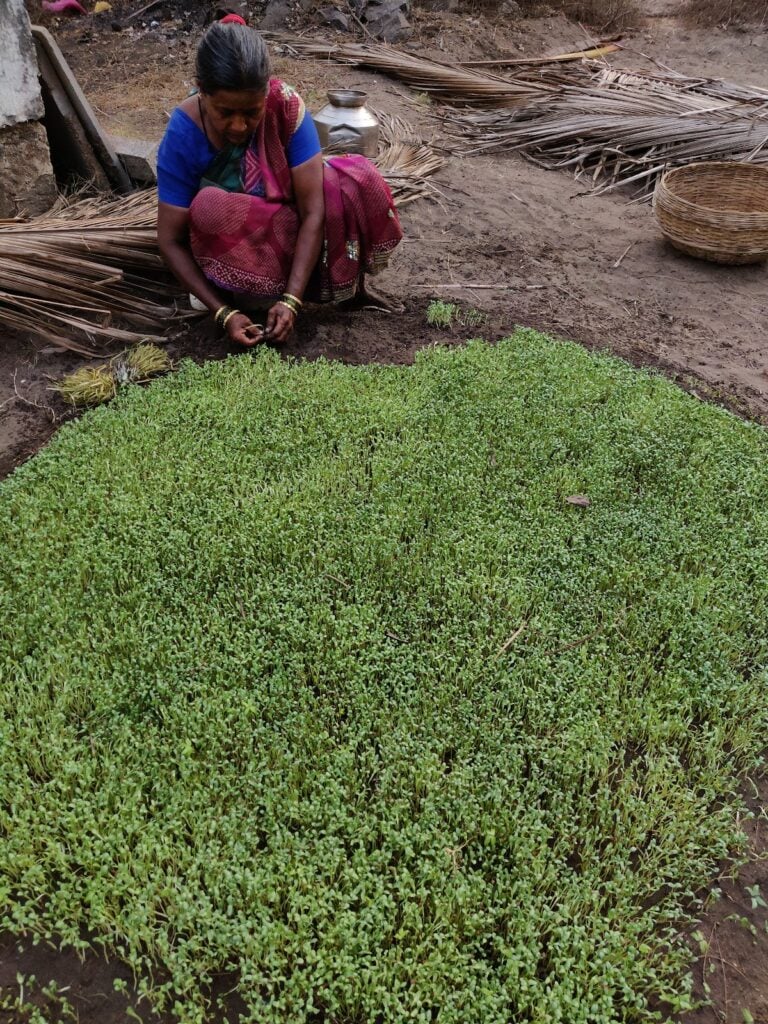
Interesting Fact: Fenugreek microgreens are a local delicacy in our region and it supports small-scale farming communities residing by the sea. The salty sand restricts the farmers to growing certain vegetables only and fenugreek microgreens grow great in these sandy zones with a little water.
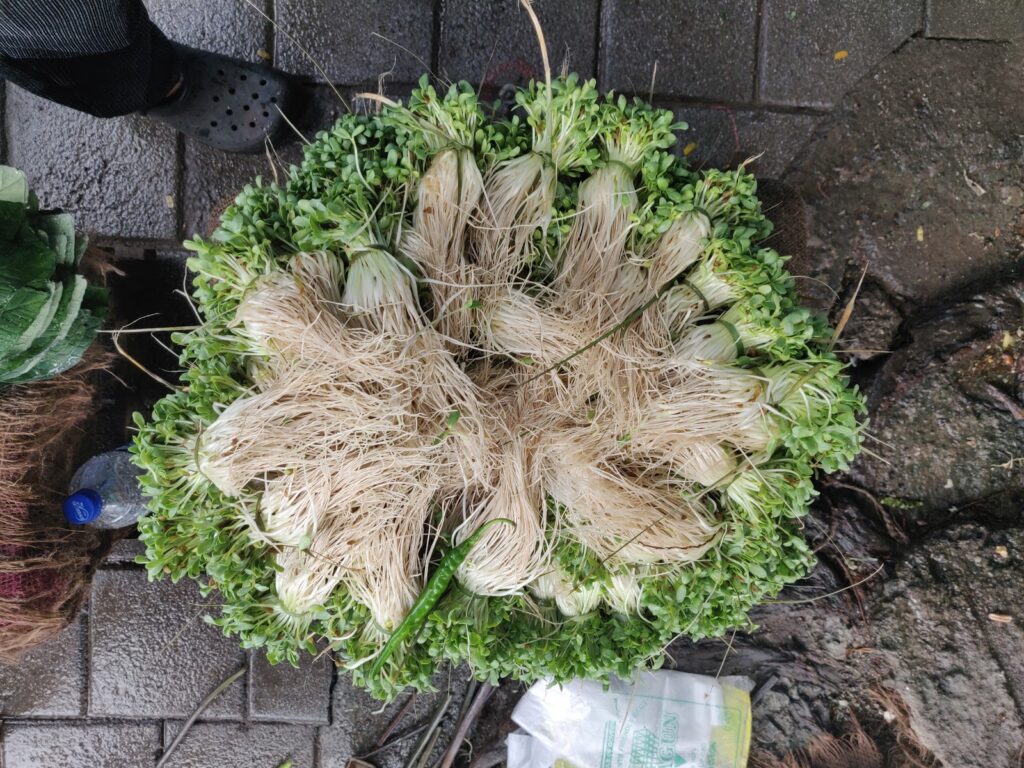
The harvested microgreens are bundled and sold in the local markets, they look absolutely stunning, they are fresh, crunchy and have a herby aroma. One can buy 20 to 25 bundles to make a sauteed version that serves 3 to 4 people.
Suitable for Growing in Diverse Conditions
Fenugreek is well-suited for both kharif (monsoon) and rabi (winter) seasons, allowing farmers to cultivate it during different parts of the year. Depending on the region and growing season, sowing is usually done between June and October for the kharif season and between October and December for the rabi season.
Fenugreek microgreens are easy to grow and can be grown with minimal in repurposed containers. In India, people can be seen growing fenugreek in cities, in tiny containers as well as they can grow with limited to no direct sunlight.

Forage Crop for Livestock
Fenugreek forage is rich in protein, carbohydrates, minerals, and vitamins, making it a valuable feed source for livestock. The forage also helps with digestion by reducing the risk of digestive disorders and improves rumen health due to its fiber content.
The plants are usually cut during the vegetative stage before flowering as it is believed to contain the highest nutritional properties. The forage can be fed directly to livestock, incorporated into their daily ration, or used as a supplement during periods of low-quality or limited forage availability.
Important Note: It is generally safe for livestock, it is important to introduce new feeds gradually to prevent digestive upsets.
Guide to Growing Your Own Fenugreek!
Fenugreek can be grown as a dedicated forage crop or intercropped. It requires well-drained soil and thrives in warm climates. It is typically sown directly into the field by broadcasting the seeds or using drills.
What growing conditions should you consider?
Climate & Temperature
Fenugreek prefers moderate temperatures. Germination occurs best at temperatures around 68°F to 77°F (20°C to 25°C). Once established, the plant can tolerate slightly higher or lower temperatures but avoid extreme fluctuations.
Additionally, fenugreek grows well in a slightly humid environment. You can provide some humidity by misting the leaves or placing a tray of water near the plants to increase moisture in the air.
Soil
Fenugreek thrives in well-draining, organic matter-rich sandy loam soil with a slightly acidic to neutral pH (around 6.0 to 7.0). However, it can adapt to diverse soil types including sand and clay. For a better yield, ensure the soil is loose and crumbly, allowing the roots to develop easily.
Sun
Fenugreek thrives in full sun with at least 4 to 6 hours of daily direct sunlight.
Water
Fenugreek plants prefer consistently moist soil. Water the plants regularly, keeping the soil evenly moist but not waterlogged as it can lead to root rot. Ensure good drainage in the planting area or containers.
Pest & Diseases
Plants are generally considered to be relatively resistant to pests and diseases. However, like any plant, they can still be susceptible to certain issues like aphids and whiteflies when grown together.
Powdery Mildew, root rot and Fusarium Wilt can be observed when the plants are over or under-irrigated. Ensure proper spacing and watering just enough to keep the soil moist consistently to avoid pests and diseases.
Remember to provide adequate spacing between fenugreek plants to allow air circulation and prevent overcrowding. This will help prevent the onset of diseases.
Growing From Seeds
Selecting the right seeds
Obtain good quality fenugreek seeds from a local reliable source. You can purchase them online as well, the seeds stay viable for 2 to 3 years however the viability reduces with age.
Sourcing Tip: Ensure your source has dry seeds, stored away from direct sunlight, in airtight containers, free from pests and moisture.
Preparing the Site
Choose a well-drained soil mix or plantation spot, you can add organic matter for better growth however being a legume, the plants can survive in nutrient-poor soils as well. Loosen the soil with a garden fork or light tiller..
However, growing microgreens need a different growing setup as compared to fenugreek grown for foliage and seeds, have covered that in the later part of the article.
Sowing Seeds
Sow the fenugreek seeds directly into the soil or in containers. Make furrows or shallow trenches about 1/4 to 1/2 inch deep and spaced about 4 to 6 inches apart. Place the seeds in the furrows, leaving a gap of about 1 inch between the seeds. Cover the seeds with soil and gently press them down.
Watering
Water the soil gently to ensure good moisture penetration. Ensure the soil stays consistently moist however, not waterlogged. Water regularly, especially during dry periods, to prevent the soil from drying.
The seeds typically germinate within 7 to 10 days with the soil temperatures ranging from 20°C to 25°C.
Caring Tips
Once the seedlings emerge, thin them out if they are overcrowded, leaving about 2 to 4 inches of space between 2 adjacent plants.
Harvesting and Storage
Fenugreek can be harvested at different stages depending on the need.
Harvesting leafy greens
You can start harvesting leafy green after 30 to 45 days once the plant starts producing leaves however before it starts flowering.
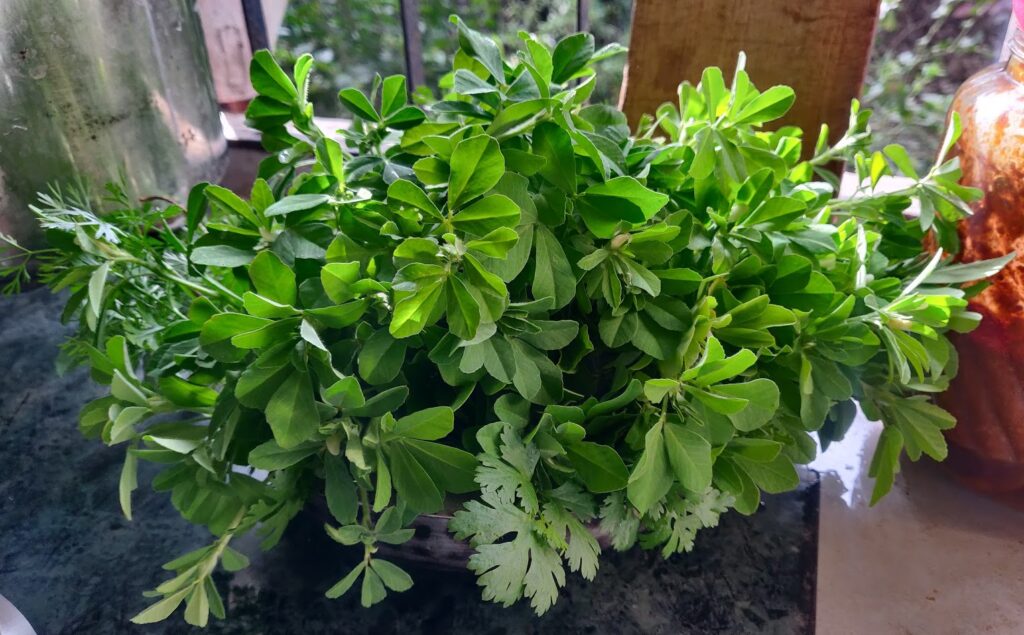
Use a pair of scissors or cutter to cut the leaves, you can harvest the top 3 to 4 inches of shoots, this also encourages branching. The tender green leaves taste great!
Harvesting Seeds
Once the seed pods have turned yellow-brown and begin to dry out, it’s time to harvest them. Carefully cut the mature seed pods from the plant, ensuring that they are completely dry and have started to split open naturally.
Place the harvested seed pods on a clean surface or in a container. Gently crush and rub the pods to separate the seeds from the pods. You can also use your hands to remove the seeds manually.
In case of large-scale production, you can directly chop the whole plants, leaving the roots in the soil and thresh them with a stick to separate the seeds from the plants
To remove any remaining debris or chaff from the seeds, perform the winnowing process. Hold the seeds a few feet above a clean surface and allow a gentle breeze or fan to blow away the lighter particles while the heavier seeds fall back down.
Storing the Seeds
Collect the seeds, sun dry them for a couple of days to reduce moisture content and store the fenugreek seeds in airtight containers or jars away from direct sunlight and moisture. Proper storage ensures that the seeds retain their flavor and quality for an extended period.
Growing Fenugreek Microgreens in Repurposed Materials
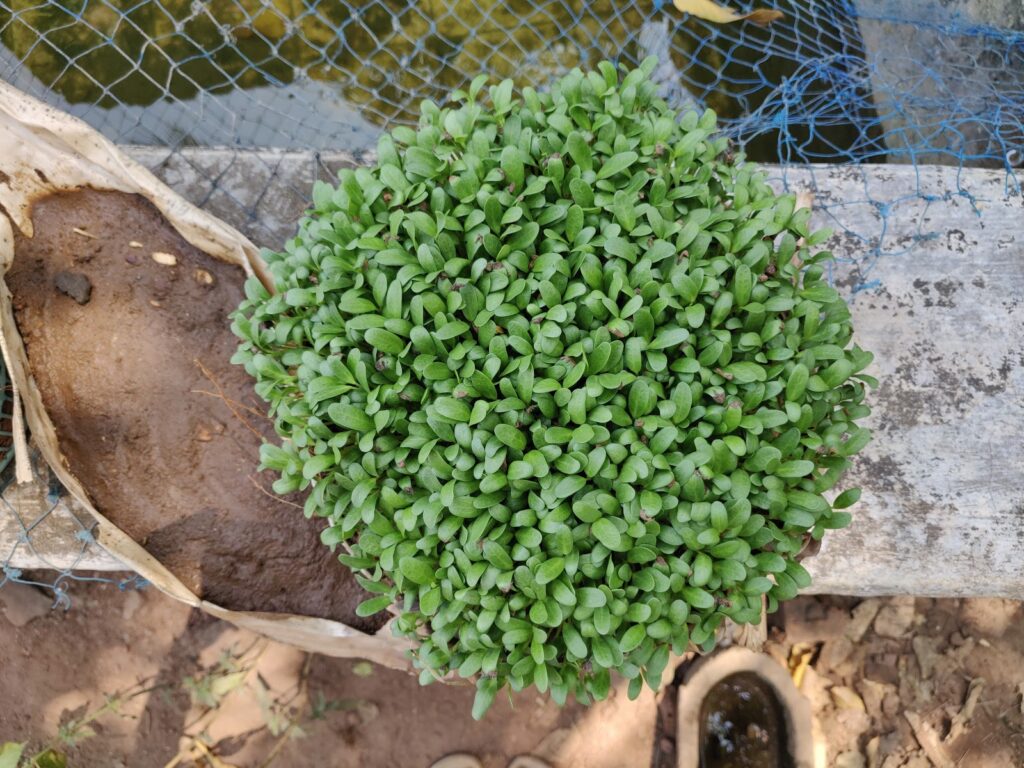
Being an easy-to-grow microgreen, fenugreek can be grown in most of the scrap stuff lying around in your house like baskets, cups, bowls, take-away containers, trays and more. It can be grown in various growing media, including soil, coco coir, peat moss, or even hydroponically (without soil).
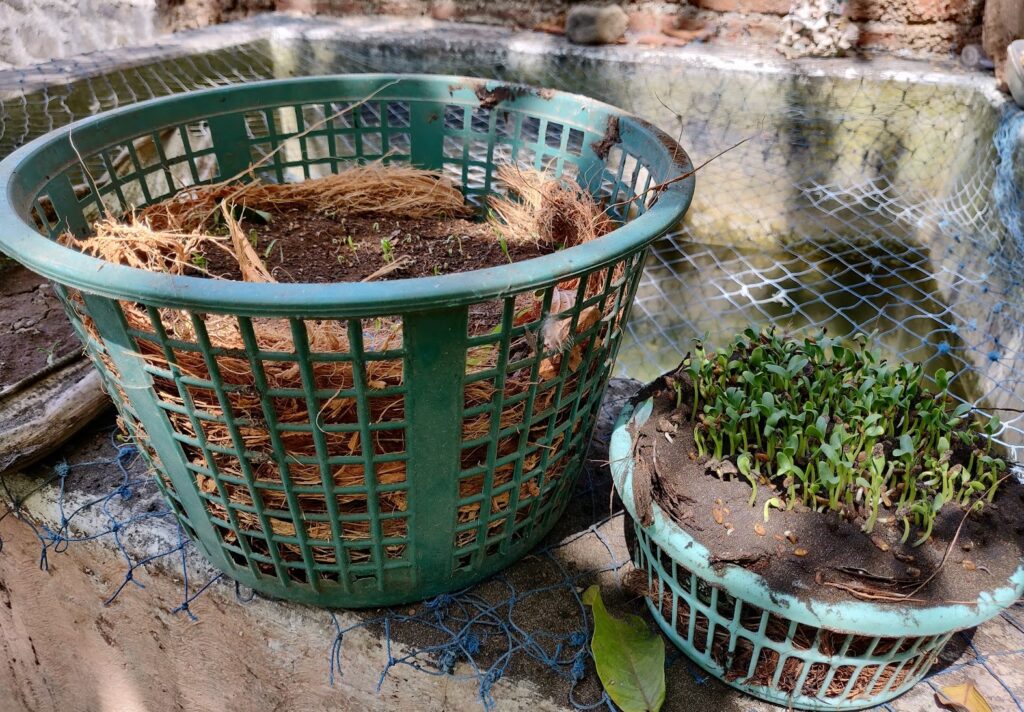
Simply create drainage holes, and seal the open sides with breathable material, we use coconut fiber which is a byproduct of our harvested coconuts, and throw in an inch of soil or compost followed by seeds. Soak the seeds overnight or at least 24 hours prior for better and quicker germination.
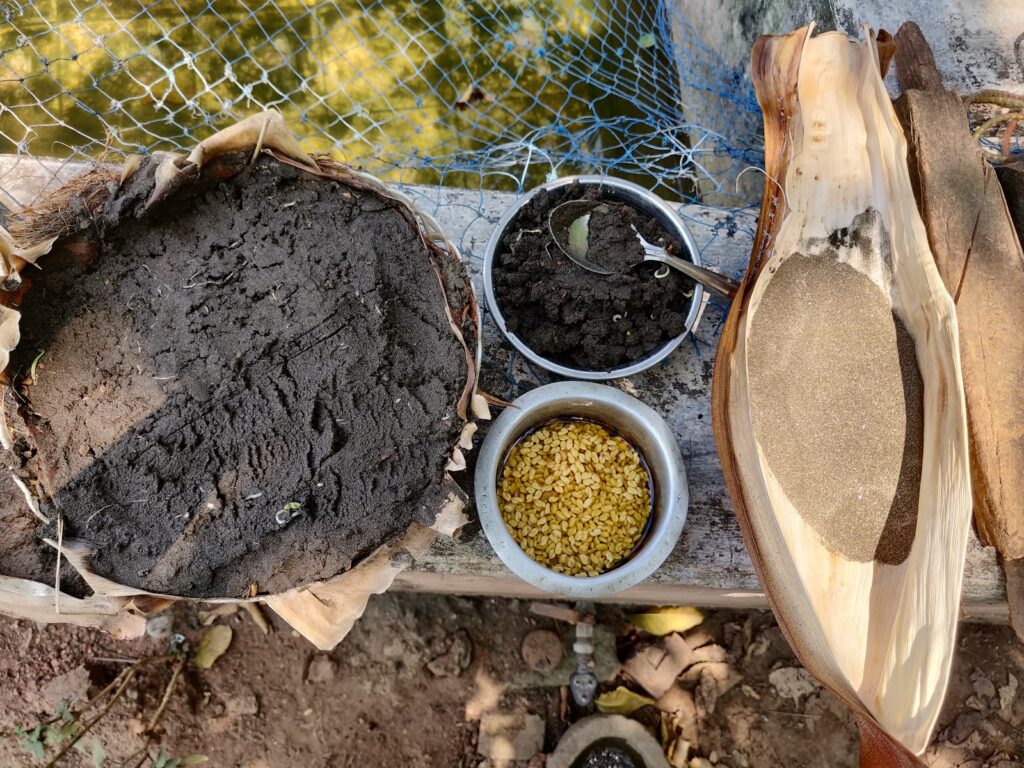
Ensure the soils stay moist throughout the growth cycle but are not waterlogged. Materials like coconut fiber help retain moisture and simultaneously ensure proper drainage.
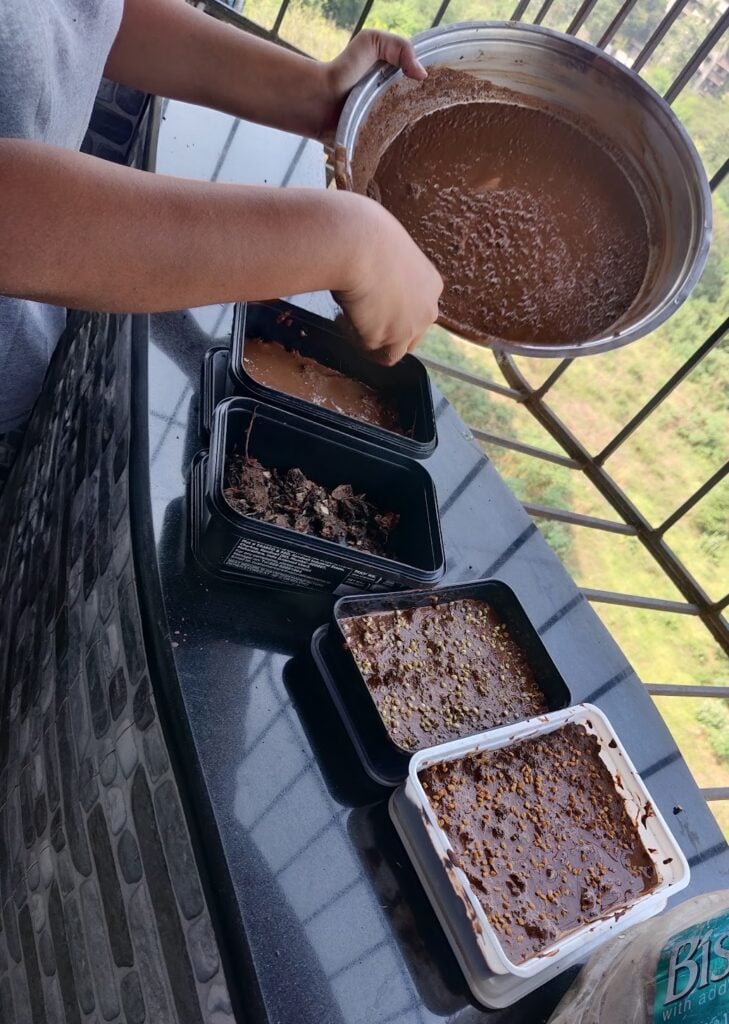
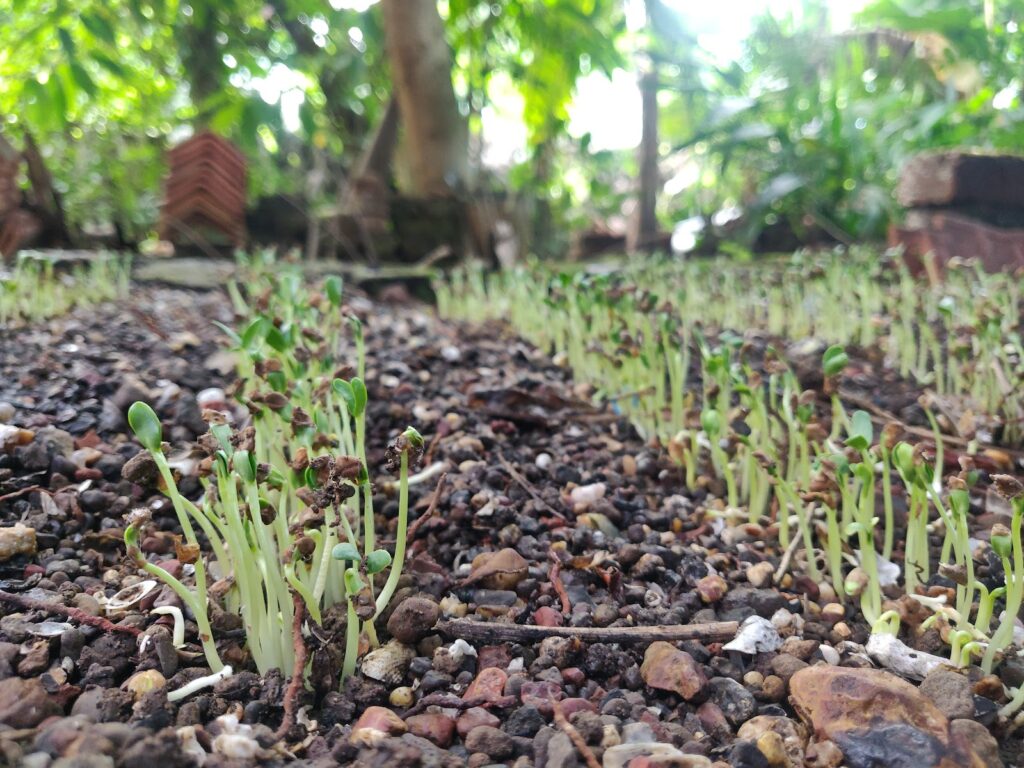
You can sow them directly in well-draining soils or sandy patches as well. Simply make rows, till the soil an inch and sow seeds densely. Now wait for 10 to 15 days and you can start harvesting the microgreens once they grow 2 to 3 inches tall!
You can plan your pots or soil patches such that you have a steady supply of microgreens as per your need.
Here’s a Quick Fenugreek Recipe from India!
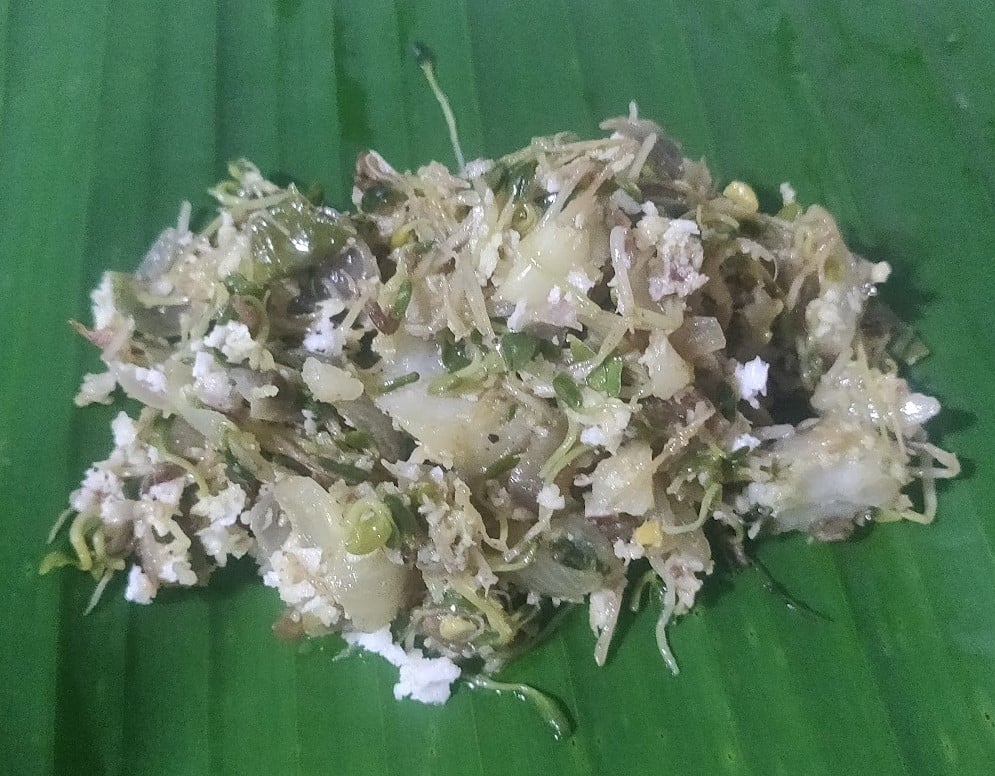
- Heat one tablespoon of oil in a pan, add 1/2 teaspoon mustard seeds and 1/2 teaspoon cumin seeds. Allow them to splutter.
- Add 1 small chopped onion and 2 minced garlic cloves, saute until the onions turn translucent and lightly golden.
- Add 1/2 teaspoon turmeric powder and a pinch of asafoetida and black pepper powder. Stir well to combine.
- Add 3 cups of fenugreek microgreens and salt. Cook for 2-3 minutes until the microgreens wilt down. Cover the pan and cook for 2-3 minutes, allowing the flavors to blend together.
- Remove from heat and garnish with freshly grated coconut (if desired).
Serve hot with roti, naan, or steamed rice. This recipe can be used for the leafy greens as well, however the cooking time needs to be slightly more for older leaves and stems.
Some Interesting Traditional Usages and Applications of Fenugreek
Culinary Usage
Seeds, Microgreens and leaves are used in different forms. The seeds are used for flavoring as a herb or spice, and so are leaves, however, leaves are made into saag or sabzi which is a sauteed recipe.
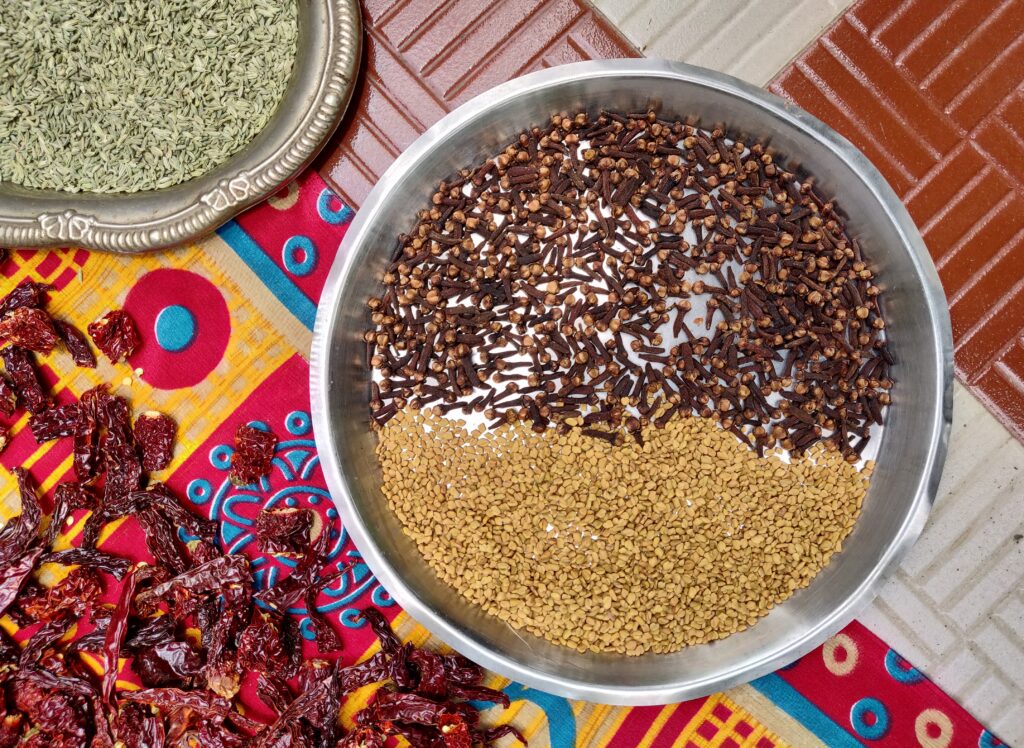
The seeds are also a part of the common spice mixes used in day-to-day cooking in Indian Households.
They are used in tadka for both vegetarian and non-vegetarian preparations.
Quick Tip: Adding a spoonful of fenugreek seeds to dosa batter changes the color of dosa, making them browner.
Traditional Medicinal Applications
Fenugreek seeds have long been used to alleviate digestive issues such as indigestion, bloating, and stomach discomfort. They contain soluble fiber and anti-inflammatory properties which help stimulate digestion, promote the secretion of digestive enzymes, and ease bowel movements. that aids in relieving constipation, reducing bloating, and promoting regular bowel movements.
The seeds are also used to address respiratory conditions like coughs, bronchitis, and congestion. It is believed to possess expectorant properties, helping to loosen mucus and relieve respiratory discomfort.
The seeds contain antioxidants that help protect against oxidative stress and cellular damage. The anti-inflammatory properties help alleviate symptoms associated with inflammation, they are traditionally used to alleviate joint pain, arthritis, and inflammation-related skin conditions.
In Ayurveda, fenugreek seeds are used to help manage diabetes. They are believed to help regulate blood sugar levels, enhance insulin secretion, improve insulin sensitivity, and reduce blood glucose levels. It can also help lower fasting blood sugar levels.
The seeds have been believed to potentially alleviate symptoms of hormonal imbalances, such as menstrual discomfort, PMS (premenstrual syndrome), and menopausal symptoms.
Research suggests that fenugreek may help reduce cholesterol levels, specifically LDL (bad) cholesterol and triglycerides. The soluble fiber in fenugreek seeds binds to cholesterol in the digestive system, preventing its absorption.
Fenugreek is believed to have properties that aid in lactation and promote postnatal recovery. The tradition involves close friends and family members making fenugreek ladoos at home and bringing them as gifts for the lactating mother, it also helps support milk production and provides nourishment.
They are commonly known as Methi Ladoos and are prepared with roasted and coarsely powdered fenugreek seeds mixed with ingredients like ghee, nuts, dry grated coconut and jaggery.
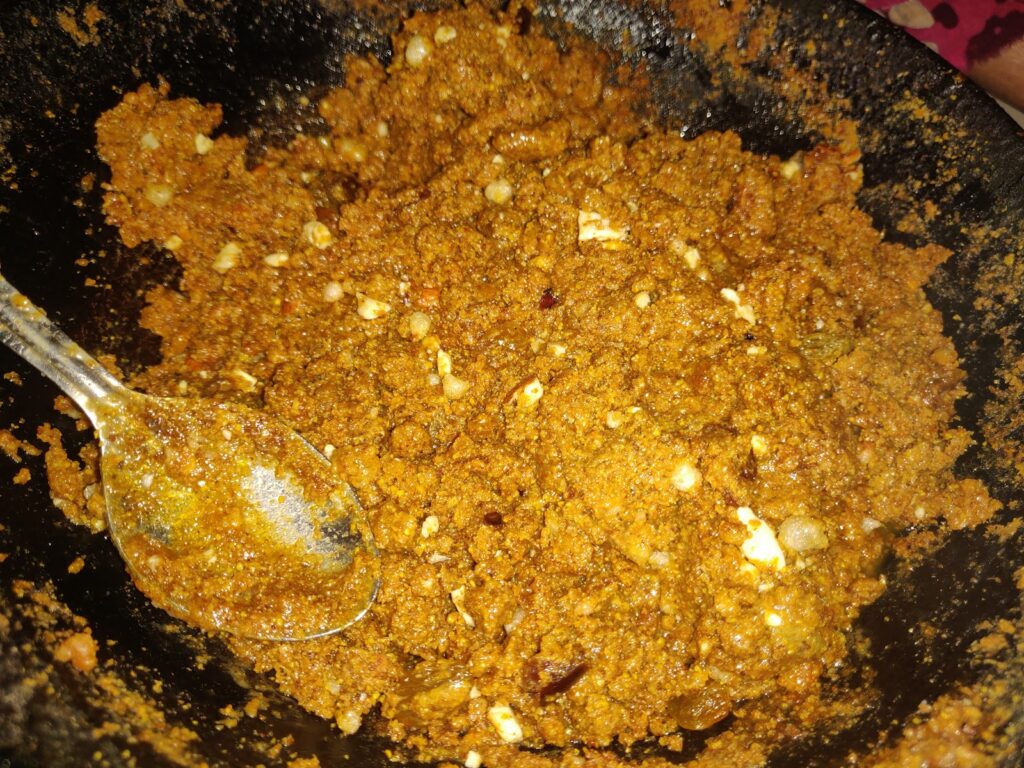
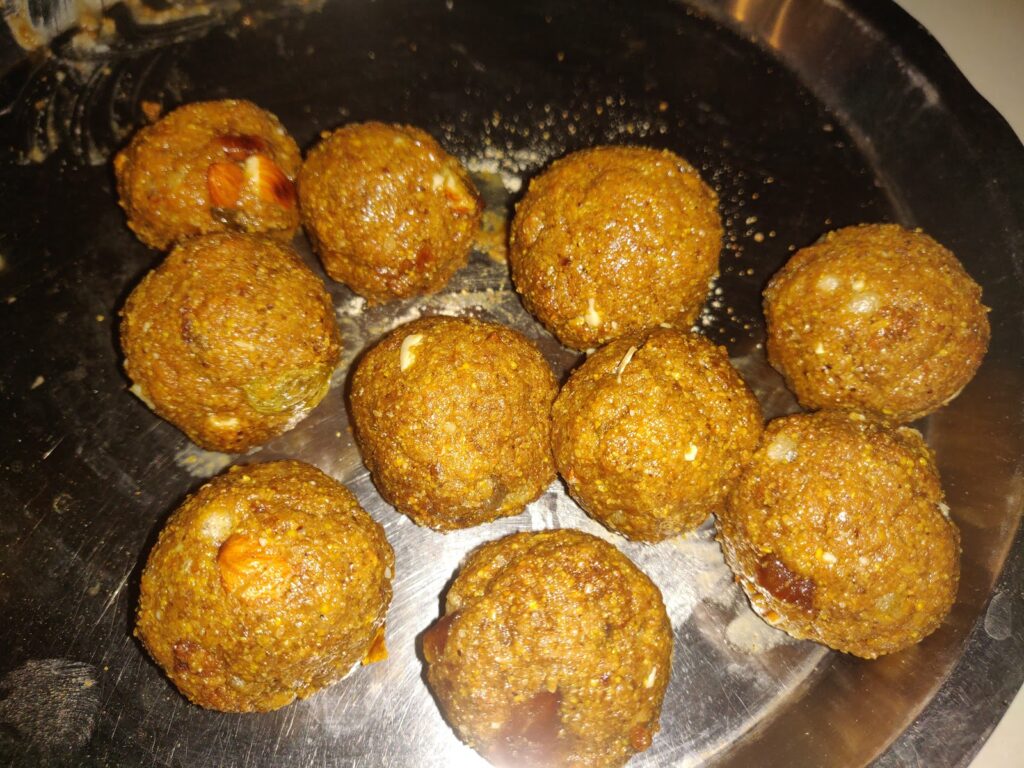
The recipe changes slightly as we move across geographies, the traditional recipes have been passed down through generations. However, the primary ingredients remain the same.
Hair and Skin Care
Hair Mask: The seeds are believed to clean the scalp, combat dandruff, strengthen hair follicles and stimulate hair growth. They are soaked in water overnight and made into a paste, this paste is either mixed with coconut oil or yogurt and applied to the scalp as a hair mask. It is left for 15 to 30 minutes before rinsing.
Quick Tip: You can grind and store the seed powder, and mix it with ingredients as per the need for instant use.
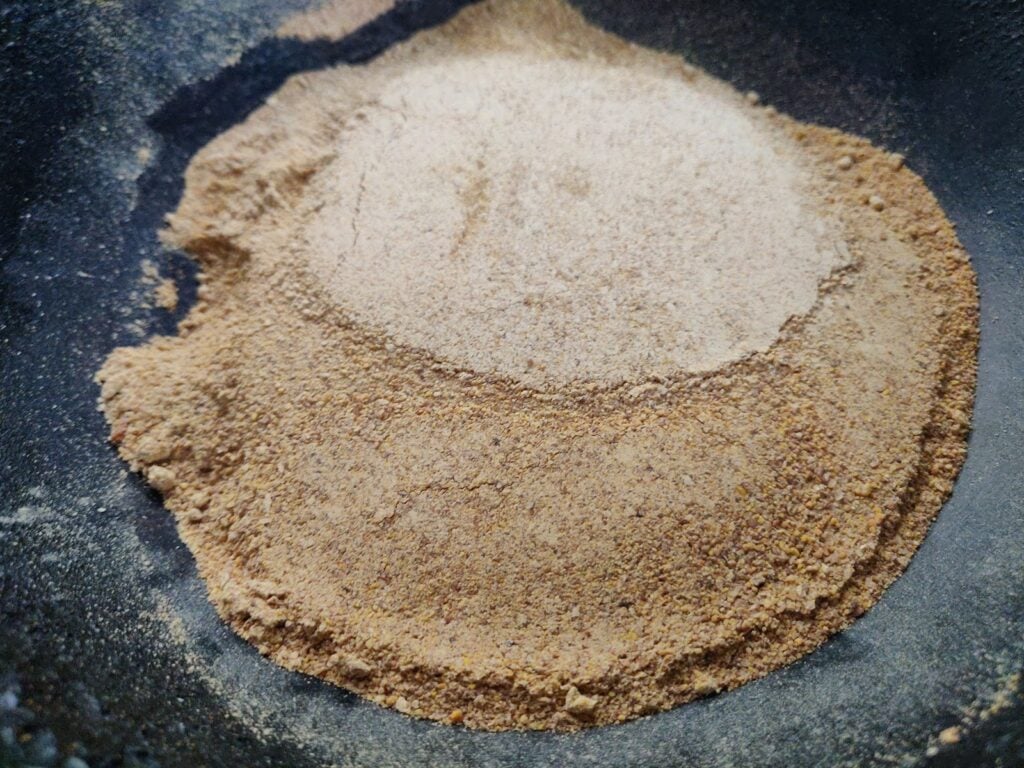
Scalp Conditioner: Traditionally, fenugreek seeds are infused in carrier oils like virgin coconut oil, mustard oil, or sesame oil for using it as a hair oil. In southern India, there are family recipes for hair oil which include adding local ingredients like curry leaves, hibiscus flowers, clove, and more to the oil. The ingredients are basically boiled in the carrier oil until they turn brown, it’s allowed to cool, strained and stored in jars or bottles. You can add onion as well to the oil, it helps the hair turn smooth and silky. Simply massage the oil into your scalp to moisturize and nourish it, improving overall scalp health.
Face & Body Scrub: The seeds are ground into powder and mixed with chickpea flour along with some turmeric and made into a paste, this acts as an exfoliating scrub. The seed powder can be mixed with other ingredients as well like yogurt or honey.
I make a face mask by mixing the seed powder with water or yoghurt, apply and leave it for 10 to 20 mins. It works great to hydrate and feel fresh!
Last but not least, here’s a quick fenugreek seed tea recipe!
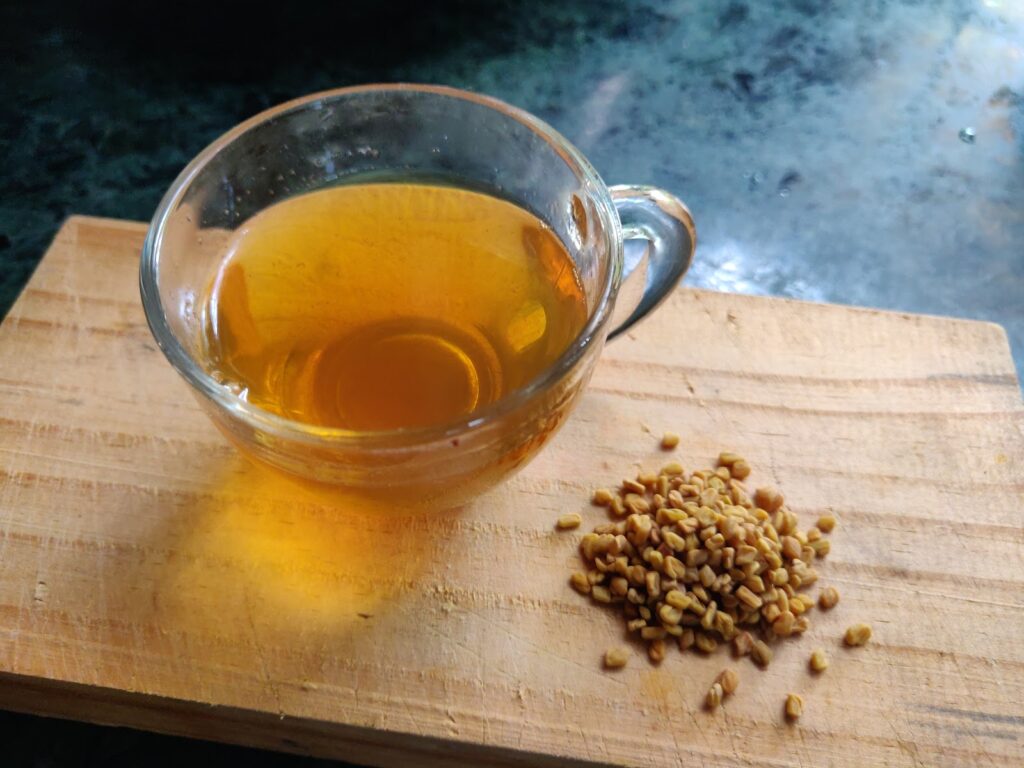
Fenugreek seed tea can be made within 10 mins, simply wash the dry seeds, add them to water and boil for 8 to 10 mins, add honey or sugar (optional) and it’s done!
10 to 15 seeds are enough for one cup of tea, having it in moderation, especially during changing seasons or wet seasons is considered good for helping warm up the body and aid digestion. It also helps alleviate symptoms of cough, congestion and bronchitis and is used to soothe the respiratory tract and promote the expulsion of mucus.
Wrapping Up: Final Thoughts on Fenugreek
In conclusion, fenugreek does offer potential health benefits and is a nutritious herb to include in your diet. However, it’s important to approach the concept of “superfoods” with caution and maintain a balanced and varied diet overall. As always, consulting with a professional is recommended for personalized advice regarding your specific health concerns.
Similarly, when growing fenugreek, it’s important to observe the behavior, the amount of inputs required to obtain a yield and the benefits to regenerating your spaces. I hope this article helps you experience and include this beautiful herb responsibility 🙂

































